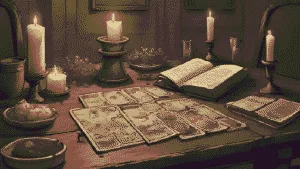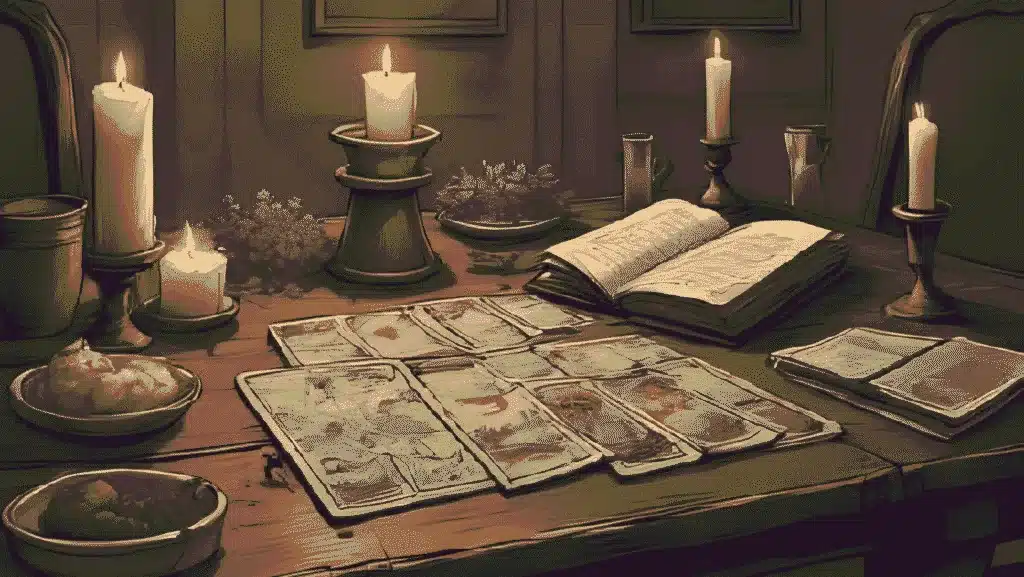Tarot for Beginners: A Witch’s Guide to the Cards’ Origins
When you shuffle a tarot deck today, it’s easy to imagine witches and mystics doing the same thing for centuries. But here’s a surprise: tarot didn’t start life as a magical tool at all. The story of how tarot travelled from Renaissance parlours to modern witch altars is full of twists, myths, and fascinating turns. This guide to tarot for beginners shines a light on where the cards really came from.
Renaissance Roots: Cards for Play, Not Prophecy
Tarot was born in 15th century Italy, not as a tool of fortune-telling but as a game called tarocchi. Wealthy families like the Viscontis of Milan commissioned ornate, hand-painted decks with lavish images of rulers, virtues, and biblical scenes. These early cards included the familiar four suits (Swords, Cups, Coins, and Batons/Wands) plus a special set of trump cards — what we now call the Major Arcana.
These trumps weren’t mystical back then. They were simply a clever game mechanic, adding an extra layer of strategy and fun. Ordinary people in Europe also enjoyed simpler versions of tarot as a trick-taking card game. In fact, tarot games are still played in France and Italy today.
So when did the “mystical tarot” appear? That came much later.
The Occult Turn: Egypt, Mystics and Secret Wisdom
By the 18th century, European mystics began looking at tarot with different eyes. In 1781, a French scholar named Antoine Court de Gébelin claimed the tarot trumps held hidden wisdom from ancient Egypt’s Book of Thoth. He believed the deck preserved esoteric knowledge disguised as a card game.
Not long after, Jean-Baptiste Alliette (better known as “Etteilla”) published the first deck designed purely for divination. He added Egyptian-inspired designs and created spreads and interpretations for fortune-telling.
Although historians now know the Egyptian connection was invented, this theory stuck — and it gave tarot its mystical reputation. From then on, tarot wasn’t just a parlour game. It became a doorway to hidden truths.
19th Century Revival: Tarot Goes Occult
The 1800s and early 1900s were a golden age of esoteric societies. Groups like the Hermetic Order of the Golden Dawn in Britain embraced tarot as a symbolic system full of magical correspondences. For them, each card linked to astrology, Kabbalah, and elements of ceremonial magic.
The most famous tarot deck of all time — the Rider-Waite-Smith deck — came from this period. Published in 1909, it was illustrated by Pamela Colman Smith under Arthur Edward Waite’s direction. Its vibrant imagery and detailed symbolism made it approachable, and it remains one of the most-used decks today.
Meanwhile, Aleister Crowley and Lady Frieda Harris developed the striking Thoth Tarot, another iconic occult deck. These creations cemented tarot as a tool of spiritual exploration, no longer just a card game.
Tarot for Beginners in Modern Witchcraft
Fast forward to the 20th century. As Wicca and modern witchcraft emerged in the 1950s and 60s, tarot became part of the witch’s toolkit. By the 1970s, tarot had gained mainstream popularity during the New Age movement. No longer confined to secret societies, it was now in the hands of everyday seekers.
Today, tarot for beginners is easier than ever. From witches casting spells to therapists encouraging self-reflection, the cards are used across countless settings. The once-exclusive game of nobles has become a universal language of symbols, guiding people through questions of love, career, and personal growth.
Myth and Magic in Balance
It’s worth remembering that many of the “ancient” tarot myths — like the Egyptian origins — are more story than fact. But myths themselves carry power. The idea of tarot as a timeless, mystical system has inspired generations of witches, readers, and seekers to use the cards for guidance.
As witches, we often work with myth and symbol as much as with historical fact. Both have their place. What matters most is what the cards mean to you when you lay them down on your altar or kitchen table.
Final Thoughts
Tarot’s journey is a tale of transformation:
-
From Italian parlour games in the 1400s,
-
To mystical tool in the 1700s and 1800s,
-
To witch’s ally in the present day.
Understanding this history helps us see tarot not as something rigid and fixed, but as a living tradition that adapts with each generation. Whether you treat it as a game, a mirror for your soul, or a spellcasting partner, tarot is a deck of cards with centuries of stories whispering through it.
Blessed be!
Don’t forget to check out my Etsy Shop for spell & ritual kits
Discover more from Lancs Green Witch
Subscribe to get the latest posts sent to your email.


